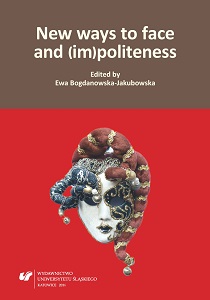
New ways to face and (im)politeness
New ways to face and (im)politeness
Keywords: sociolinguistics; intercultural communication; politeness; impoliteness; the concept of face
More...
Keywords: sociolinguistics; intercultural communication; politeness; impoliteness; the concept of face
More...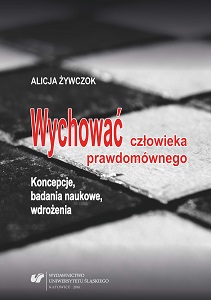
Keywords: truthfulness; truth; educational process; moral virtue; character trait; moral value; epistemic value
Common among contemporary Europeans is the belief that “everyone has a right for his or her own truth” or to express their, often very subjective, version of the truth. The classic idea of truth is not particularly popular while various kinds of untruth are treated exceptionally leniently. Copywriters avail themselves of numerous means of persuasion and gain consumers by means of truth manipulation: the truth is shown as untruth or it is concealed or distorted. Not only does their free use of manipulation go unpunished, on the contrary, it is counted among their professional successes. The same applies to the sphere of politics where the problem of separating the truth from the objective reality using sophisticated manipulation seems most acute. In today’s social life, which abounds in examples of shady business, people are increasingly more often offered vague explanations or establish complicated relationships in which it is not uncommon to come across a garbled version of the truth. The escalation of lie over the last decade among various social circles, from the family and the school to the entire country to the continent or even the whole world, causes in a certain group of people a definite dislike towards untruth resulting from cunningness, egotism or particularism. Such people continue to try and attain the truth and manage to discover it with satisfaction. The desire for veracity is all the more justified in such a situation. Such an attitude, coupled with other personal traits, paves the way to leading a good life. The reasons I chose this particular subject matter for my research are both the threats to the truth listed above as well as my rejection of untruth in the public life, the desire to protect children and the youth against liberal decrease of sensitivity to the lie, insufficient love of the truth and underappreciation of veracity. In the world of today, despite the fact that pretended values and phenomena are being treated with more and more appreciation, mere appearances or mystification are being openly adored, the veracity standard that results from the desire for authenticity and honesty remains active in the human self-consciousness. In my research, whose results eventually materialized in the form of this monograph, I followed the desire to preserve for posterity the world in which one seeks the truth in order to feel the cognitive satisfaction, the world in which one undertakes wise and effective actions, intending to avoid the tragic outcome of defeat caused by being led astray in his or her pursuit of knowledge or being exposed to collective illusion; something goes wrong, appearances, falsehood and the stereotype win the day. It is worthwhile at this point to explain to the readers why this monograph was written at all. My purpose was not to review or sort out all the research projects (theories, concepts or views) in the subject matter at hand but rather to focus on the upbringing effects of the research material and how it raises the level of social awareness, to thoroughly discuss the phenomenon of the truth and veracity and to work out my own pedagogical standpoint. As far as I am concerned, each generation should ponder the necessity of respecting such a value as truth, enhancing it with new individual components, typical of a given historical or civilization period. The main research problem is: In what way in the process of upbringing should one shape veracity in the youth? The aim of my research was to learn what the youth think about the truth and veracity, how they understand the truth, what their relation to such a value as truth is, what kinds of veracity and non-veracity they are familiar with, and what they know about: communication situations conducive and not conducive to telling the truth, the circumstances requiring unconditionally that the truth be told, the feelings accompanying the lie and revealing of the truth, other features of character of a truthful individual, methods of upbringing toward veracity within the family, school and the peer circle, participation of the parents, teachers, classmates, friends in the process of shaping the foundations of veracity; authorities of veracity, valuation of the behavior of truthful and mendacious people, the necessary deviation from the principle of veracity, the reasons and effects of non-veracity; the difficulties in adhering to the norm of veracity in the contemporary world, the significance that is ascribed to veracity in the sphere of individual development and social functioning. It seemed important to seek the answer not only to the main research question but also to many detailed problems, especially: what values opposite to the truth and veracity are the young people above the age of 12 exposed today and what variants of non-veracity do they most often interiorize? By means of what principles, methods, forms or message do the parents and the teachers bring up truthful people? Does mutual veracity improve communication (upbringing dialogue) between the teacher and the student? Apart from the cognitive purposes, in my opinion, there were also other important aims in my research, including: utilitarian aims (connected with the raising of the level of awareness concerning the cognitive and moral function values in the collective life) and upbringing aims (the shaping of moral habits, such as telling the truth; promoting the principle of veracity in the upbringing relations within the framework of, e.g. axiological education). Promoting such issues may prove to be of inspirational value for the representatives of many research circles including philosophers, sociologists, anthropologists, psychologists, teachers interested in epistemology, theoretical and applied ethics or the theory of moral upbringing and praxeology. The 2014—2015 study group consisted of high school students (2nd and 3rd graders) from the following Silesian cities: Katowice, Gliwice, Bytom and Tarnowskie Góry (320 subjects aged 17—18). In the first chapter of the monograph I specified the term of veracity and identified the constitutive properties making up the nature of this psychic disposition. Simultaneously I referred to the classic aspects of axiology (kind of truth and veracity) and the theory of cognition (the way the truth and veracity exist, epistemological and ontological concepts). Placing the problem within the research scope of pedagogics (and its numerous sub-disciplines) and related disciplines (especially anthropology, psychology, philosophy, sociology, history) made it possible to focus the analysis on the problem of science studies and the modern professiology — the shaping of veracity in science practitioners and researchers. I offered the thesis that both the individual research development and the progress of science understood as a cultural quality occur by means of such a personality trait of a researcher as veracity. In the second chapter I justified the individual and social significance of veracity indicating that it constitutes a moral norm used in building trust, and allowing the society to survive and integrate. In view of the fact that the attitude towards the truth is also an important gauge of humanity, I explained the relationship between veracity and other ideal values such as: love, respect, courage, justice, fidelity, responsibility, peace, freedom, honesty, beauty, and the related character traits. I argued the views of the representatives of the pragmatic concept of the truth, without omitting to discus the numerous functions of the truth and veracity. The analysis and interpretation of the results of the studies made it possible to present extensive argumentation of the examined youth supporting veracity and opposing the lie. I laid emphasis on the significance of veracity in strengthening the stability of the relationship between classmates, friends, spouses and for the building of the familial cohesiveness. The third chapter invites the reader to analyze the contemporary methods for discredication of the truth and for questioning the model of veracity. Consumerism and utilitarianism have been shown as phenomena jeopardizing the moral culture of “post-modern” societies responsible for the fate of veracity — will it survive or will it ultimately be neglected. I identified, on the basis of various criteria, many variants of non-veracity, such as: presupposition, allusion, implicature and insinuation. I did not ignore here the analysis of the necessary deviations from the principle of veracity. I assumed a negative attitude towards the students’ strategy of avoiding telling the truth to the teacher, putting it down first of all to the lack of mutual trust. Among common distortions of veracity and drawbacks of collective life, in my opinion, are also slander, libel, defamation, gossip, rumor, machiavelism, cherishing prejudice and following stereotypes, characterized in detail in the chapter. Among controversial instances of truth denial are, as far as I am concerned, utopism and cultivation of myths and illusory conceptions (illusions). I indicated the importance of shaping in the young generation the proper beliefs strengthening the desire to achieve the truth and helping to reveal illusions that often make one less active in life. In the fourth chapter I did not limit myself to describing the causes for non-veracity but made an attempt at fathoming the reasons for veracity. With this in mind I discussed the extrinsic (e.g. social, cultural, political, educational, situational, religious) and endogenous (e.g. habits) determinants of veracity. In order to present a wide array of etiological concepts, in which the problem of lie is addressed not perfunctorily or marginally, but in a reliable way, both psychologically and pedagogically, I used the upbringing propositions of several renowned pedagogists (Ellen Key, Alexander S. Neilla, Janusz Korczak) of European descent and Rabindranath Tagory, a promoter of an Asiatic concept of upbringing. I hope that associating the cultural output with modernity, i.e. the outcome of my own studies, which may be metaphorically termed “the voice of the contemporary Polish youth”, will produce the expected effect in the form of proper attitude toward the lie and a response consisting in adopting wise solutions to complex pedagogical problems. In the fifth chapter I discuss the theory of upbringing, applied ethics and pedagogical praxeology, all related to the understanding of veracity as a component of the ideal of upbringing, the principle of upbringing, the aim of the dialogue between the educator and his or her students, teacher’s or pedagogist’s tasks, responsibility towards the truth, obligations towards oneself and the others. The sub-chapter on identifying truth and veracity in upbringing relations and situations and the effective prevention of the problem of mendacity constitutes a certain kind of pedagogical prompt. I showed the internal struggle of a human being, related to opting for the truth and rejecting its opposites; I also stressed the regulatory function of the emotional sphere in the process of making correct moral decisions. Also shown in this chapter is the significance of shaping the most neglected sphere of the human development, the volitional sphere (including a number of related features, such as: perseverance, consequence, endurance, psychic resistance, regularity, conscientiousness, diligence, reliability, honesty) in the process of maintaining the attitude of veracity and counteracting the lie. In the last sub-chapter I supplied a number of hints for the parents and teachers on how (not only by means of sanctions) one can bring up a truthful person; what upbringing methods, forms, means and contents may prove helpful in achieving this aim. The annex consists of excerpts taken out from essays produced by the examined high school students on the topic of: “The Significance of Truth in My Life — Childhood, Youth, Adulthood”. This final part of the monograph complements the presented theoretical concepts and interpretations of the research results; from the practical point of view, it will also prove invaluable in inspiring parents, teachers, educators, pedagogists, care-providers, curators, animators, moderators, family assistants or therapeutists to undertake selfreflection and to discuss and use the presented concepts in work with young people (e.g. in axiological education, including exercising personal maturity, ethical efficiency and interpersonal skills) during the educational, ethics, religion or other lessons using activating methods or during after-school classes. The complexity of modern social life and the stress that the economic factors exert on humanistic standards causes one to rightfully worry about the fate of societies and the individual; they may be led astray by political, philosophical, psychological, sociological and other theories, which strain the axiological sensitivity of the human being, leading it to the cultural and moral wilderness. A teacher working with the young generation should make sure that their students do not compensate their creative intelligence with cunningness or being smart; he or she should also prevent them from replacing an awkward or unesthetic truth with a convenient lie. I thereby take a great pleasure in dedicating this monograph to all the professionals bringing up children according to the best tradition of veracity.
More...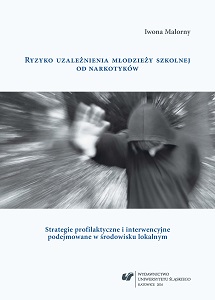
Keywords: youth; risky behavior; drug; prophylactic strategies; interventional strategies; drug addiction; danger to life; health hazard
The book addresses an issue of drug abuse, which is becoming a growing social problem in Poland. The socio-economic and political changes in recent years have increased the number of factors detrimental to children and youth. As a result of this, increasingly more young people turn to psychoactive substances. What is particularly alarming is the increasingly younger age of children who begin to use a substance. Hence, the following book is addressed mainly to teachers/educators/parents with an aim to provide them with indispensable knowledge to help them protect children and youth from the hazards and consequences of drug abuse. This monograph presents the latest trends in addiction prophylaxis and interventional strategies to be employed in the event of hazards to life and health with persons under the influence. It also prompts for reflection on the quality, adequacy and efficacy of the prophylactic actions undertaken by specialists. Drug addiction inflicts irreparable harm in every sphere of human life. Its enormous social costs make the intensification of actions aimed to curb substance abuse an urgent social need. As shown by the reports from the NIK (Supreme Chamber of Control), actions were initiated in Poland to create a comprehensive drug abuse profylaxis system for school children and youth at all levels of education. These encompass mainly designing projects to prevent drug abuse at particular administrative levels (including schools) and assigning specific tasks to appropriate authorities, institutions and entities. However, the so far implemented actions have not produced sufficient prophylaxes, and the quality of actions undertaken within the framework of these projects turned out to be inadequate to the scale and significance of the problem. The book consists of three chapters. Chapter one discusses the issues relevant to drug abuse including the causes, ways of prevention and strategies of intervention. It also presents the conception of assimilative prophylaxis, which is a new approach towards work with youth at risk of drug addiction. Chapter two presents the methodological premises for author’s own research, which was conducted according to clearly defined procedures and research strategy. It also analyses the results of studies on premises of Centrum Interwencji Kryzysowej i Przeciwdziałania Uzależnieniom (Centre for Crisis Intervention and Addictions Prevention) in Bytom in 2014. They encompass an analysis of survey data and data obtained from interviews with the addicted persons treated in the above mentioned institution. Chapter three proposes scenarios for classes within the framework of the author’s own project of therapeutic actions based on the conclusions of research and founded in assimilative prophylaxis. This project was implemented in Katolicki Ośrodek Rehabilitacyjno-Wychowawczy „Dom Nadziei” (Catholic Rehabilitation-Education Centre „House of Hope”) in Bytom on a stationary round-the-clock ward for therapy and rehabilitation of youth.
More...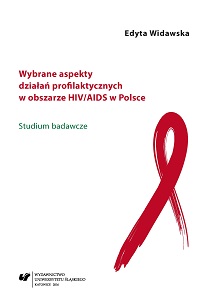
Keywords: HIV; AIDS; pro-health strategy; Poland; preventative strategies
The issue of HIV/AIDS is an essential aspect of the discussion about health-related strategies on a global and local scale. According to the data UNAIDS for the year of 2015, the number of people who are aware that they are infected with HIV and recognize their status is approximately 36.7 million all over the world. In Poland, since the beginning of the research in 1985 to 29 February 2016, the incidence of HIV infection had been found in 20,169 people. The estimated data of the National Centre for AIDS indicate, however, that the number of people infected with HIV is much higher and ranges between 36 and 45 thousand people. This puts our country at the forefront of the European Union countries in terms of the number of infected people who are not aware they have contracted this disease. The expenditures on the preventative measures against HIV in Poland are decreasing year by year. In 2007, still as much as 3.5 million PLN was engaged in the preventative measures against HIV/AIDS, however in 2013 and 2014 the amount dropped to 2.5 million PLN. Such a significant depletion of funds must have resulted in a drastic reduction of the initiatives aimed at raising the level of public awareness of HIV/AIDS, and other preventative actions. After the abovementioned issues have been taken into account, a research project was launched that was aimed at analyzing the preventative measures taken in our country in the years 2013–2014. The Social Committee for AIDS decided to carry out, in collaboration with the Association of the National Network of People Living with HIV/AIDS “Network Plus”, a national research focused on the analysis of the condition of primary prophylaxis (access to the information, education and services in the area of HIV/AIDS prevention), secondary prophylaxis (access to the information, education and services in the area of HIV/AIDS prevention for persons with an increased level of risky behaviour) and tertiary prophylaxis (measures to improve the quality of the psychosocial sphere of life towards the people infected with HIV and AIDS, their families and the loved ones). The results of the research and the analysis presented in this publication are focused on the current situation, which allows the acquisition and the comparison of multi-dimensional data on the implementation of the National Programme for Preventing HIV Infections and Combating AIDS. The study was undertaken by public institutions (including regional offices, marshals’ offices, provincial sanitary-epidemiological stations), non-governmental organizations implementing preventive measures in the area of HIV/AIDS, people living with HIV/AIDS, and infectious disease physicians who work with people living with HIV/AIDS on every-day basis. Such an orientation of the research resulted from the major aim of the research, which was to diagnose and examine the implementation of the preventative measures taken by public institutions within the National Programme for Preventing HIV Infections and Combating AIDS developed for the period of 2012–2016, and thus, i.e. on this basis, to produce recommendations for the further planning of preventative measures in our country. The work consists of three chapters and has the nature of a theoretical and empirical study. The first chapter contains the issue substantial for the subject matter, i.e. deliberations about the very essence of preventative measures, within which different forms of activities have been distinguished according to the adopted target groups of the preventative interventions. The second chapter is a presentation of the methodology adopted in the framework of the research. The third chapter comprises the research results and the discussion on them. The research project, which constitutes the basis for the prepared publication, was carried out with the support of the Stefan Batory Foundation within the programme entitled Citizens for Democracy, financed with the resources of the Financial Mechanism of the European Economic Area.
More...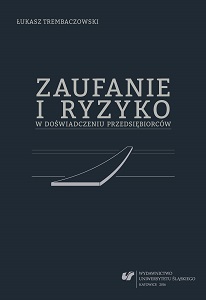
Keywords: Trust; Risk; Polish law; Theoretical aspects of risk; Entrepreneur in society; Sociological theories of trust
The main theoretical framework for the following monograph has been built around the two titular concepts: trust and risk. Due to the lack of a coherent methodology which connects the two, each concept will be discussed in greater detail in a separate chapter, which will contain a thorough overview of the major conceptions of trust and risk. This overview, in turn, will be summed up with an analysis of the mutual relationship between the two, in order to conclude that trust and risk appear to be antithetical in the praxis of the experience of a social agent. The primary subject of the study has been the way trust and risk are experienced by entrepreneurs. The choice of this particular group has been dictated by the fact that it constitutes a distinctive research “laboratory,” which combines the problems connected with engaging in business activity with the everyday dilemmas experienced by individual subjects across society.The empirical part of the monograph, apart from conceptualizing and operationalizing theanalyzed issues, consists of two parts devoted to trust and risk respectively. The primary research elaborated upon in this monograph was conducted in two parts, in 2007 and 2013. The two years differ significantly when it comes to the economic situation, since 2007 can be regarded as the height of the market boom connected with Poland’s entry into the European Union, while 2013 can be regarded, per analogiam, as the height of the market slump due to the economic crisis that started in 2008 and belatedly affected also the Polish economy. In both years, the research was conducted in Tychy, even though it did not follow the panel research structure, among randomly selected entrepreneurs who employed at least one person.In the chapter devoted to trust, the research has been conducted on the basis of Piotr Sztompka’s theory of trust. The main aspects which have been analyzed include the question of the objects of personal, positional, institutional, procedural, and systemic trust. Moreover, the author searches for immanent and contextual criteria of evaluating trustworthiness in relation to efficiency, axiological, and fiduciary expectations, as well as functional trust substitutes. The comparative study of research results from both years allows to determine the range of variability of these components of trust.The part of research devoted to risk is, in turn, based on the psychometric and axiomatic paradigm of the psychological theory of risk. However, changes have been made when it comes to the assessment and the list of risks presented to the respondents, which was constructed on the basis of Marek Ziółkowski’s hierarchy of threats and supplemented with risks which appear in the conception of risk management. On the basis of factor analysis, in both cases, the author has differentiated three main explanatory factors which bear similar characteristics and consist of similar components. Therefore, it can be concluded that the structure of risk perception among entrepreneurs is stable. Moreover, it is possible to observe the changes in perception of the particular risks within the factor space. Comparing the results of the estimated level of risk with the use of the axiomatic paradigm, extended to include the controllability dimension, allows to, on the one hand, observe the similarities between the risk profile of the particular risks, assessed on the basis of the axiomatic approach with the added controllability factor, and, on the other hand, facilitates the observation of the shifts in the rankings of business risks while maintaining the risk assessment of private risks.
More...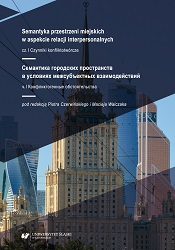
Keywords: semantics; urban spaces; city; conflict; hipermarket; park; neighbors
In the present monograph, the authors attempt to reconstruct not so much the image of a city itself in the mind of its contemporary inhabitants, but rather on the basis of the analysis of linguistic data regarding some typical urban objects, and typical for them situations, they try to indirectly reconstruct the image of urban space in the mind of contemporary Polish or/and Russian language speakers by means of describing the ideas concerning selected typically urban spatial objects (e.g. parks, megastores, a housing estate, a block of flats). The point of departure has been the compilation of language data and on its basis, the specification of the so-called category of the sensitive. The authors introduce this term to denote some inner, mental, psychological experiences and states that the inhabitants of a city, who are simultaneously the speakers of the languages under inspection, feel (sometimes unconsciously), when they speak or think about these objects (referred to as loci in the book). This, in turn, is reflected in how the inhabitants talk about these objects and typical/atypical situations connected with them. Due to a kind of interdisciplinarity and multidimensionality of the problems in question, encompassing not merely linguistic issues, the monograph may be of interest to the representatives of various academic disciplines – sociologists, anthropologists, psychologists, and philosophers.
More...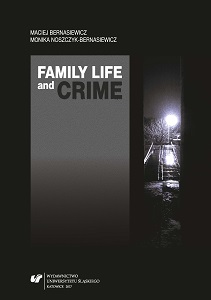
Keywords: network; postmodernism; culture; civic activity; urbanity; seniors; networking; terrorism
The family crisis reveals serious fissures in the very foundations of the European cultural community; likewise, criminal and moral degradation of youth points to the crisis of the family as an important source of the problem […]. The authors make a strong casefor the view that destructive peer relations become criminogenic factors only when they are combined with dysfunctional family-of-origin settings. In such circumstances, the authors argue, timely institutional decisions and their appropriate implementation, while always fraught with the risk of stigmatisation (as in the case of measures involving confinement), often prove to be rational actions undertaken to stop the psychological degradation of the juvenile. This conclusion is important in that it contrasts with the claim, today often overstated, that institutional forms of care for juvenile delinquents, without exception, bring more harm than benefits […]. I am convinced that the book will be of interest both to Polish rehabilitation practitioners and theoreticians as well as to international readers. For the latter,it may be an interesting source of information about the present condition of Polish rehabilitation research and compelling problems that the system of juvenile delinquency prevention in Poland is now facing. - From a review by dr hab. Mariusz Sztuka, Head of the Department of Social Prevention and Rehabilitation, Jagiellonian University, Kraków
More...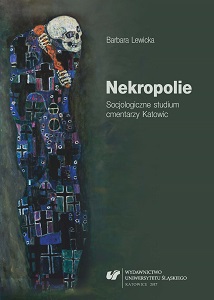
Keywords: cemetery; necropolis; urban space; memorial place; significant place; Katowice
The book entitled Necropolis. Sociological Study of the Cemeteries of Katowice, is an attempt to description of the burial spaces on the example of one city. Cemeteries shall be treated as a cultural text, reproduced in various forms of social practices. Reading this cultural text allows to reconstruct contemporary roles and significance of urban cemeteries, and describe construction of the graveyards and show typical activities undertaken in their spaces.The opening chapter clarifies the social history of the funeral spaces of Europe described terms of in four stages of development. The further part is devoted to necropolis of the particular city – Katowice. The author makes a description of the form, shape and infrastructure of cemeteries and reminds history of the city. Another part of the work is a theoretical debate on urban issues, including emphasis on urban sociology. The continuum: space – the city – a place – non-place is explained, as well as the functional division of urban space. Than graveyards are described in terms of various sciences. In this part of the book preliminary analysis of research on functions of Katowice burial spaces are related. A consequence of above is construction of the typology of modern graveyards functions in sociological terms. The rest of the book is devoted to the analysis and interpretation of results of empirical studies (combining both quantitative and qualitative research methods) carriedout in Katowice. It begins with description of burial spaces treated as separated areas of the city; the second aspect of the analysis is a description of cemeteries’ structure; another is focused on the functioning of graveyards; the last one specifies the meaning of the cemeteries for the residents of the city.This approach allows to recreate multi-faceted image of urban cemeteries. Firstly, image of necropolis with permanent and temporary components of the visual universe is analyzed. Secondly, events that took place within the cemeteries and practices associated with visiting the graveyards are described, as well as the way of functioning of cemeteries – their daily, monthly and yearly rhythm. Thirdly, answer to the question about the meaning and place of burial spaces in the minds of Katowice residents is given.Among the most important conclusions of work it should be noted that the residents of Katowice believe that burial places have important socio-cultural role. Cemeteries are described as important, meaningful and long-lasting spaces; areas of interaction and symbolic exchange. It is because, among other things: the universality of visits to cemeteries, what is associated with their rhythm of functioning; a multitude of activities undertaken in cemeteries (not only those related to its first roles); an affection to the image of tombstones; awareness that cemeteries are not only a places of remembrance for everyone who buried their relatives there, but also for the city, region or even the country; the conviction that cemeteries should be show the youngest, to familiarize them with the historical heritage and create a kind ofsymbolic attachment with the ancestors.
More...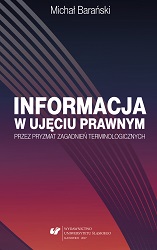
Keywords: Information; knowledge; law; definitione; terminology
The term “information” is in operative use, to a changing degree, in many legal norms obliging in Poland. At the same time, notwithstanding law branch, both in legal science and judicature, “information” is emphasized as a very complex notion. Recently, with the development of information socjety and technological progress, within doctrine there have started to gradually evolve distinct views which describe the semantic scope of information. However certain lack of consistency in terminological issues concerning information generates serious doubts as to ascribing its legal status. Information, thus far has not been subject to complex considerations of law science. In this respect, judicature either, does not provide plausible material for analysis. In order to establish the range of the term “information” it was first of all necessary to reach for other domains’ achievements (for example to economy) and colloquial language as well. A connection between information and personal data, and databases was shown. Another part of the publication was also dedicated to presenting the term “information” in a functional aspect against the term “information” in an objective aspect.Besides, information regulation in constitutional law, administrative and criminal ones were mentioned. Further part was dedicated to terminological issues concerning information, however viewed through exact civil law regulations. The analyses concerning legal interdependencies between an advertisement, a commercial and economic information were performed. Moreover, the regulation dealing with the press law was presented with information perspective.
More...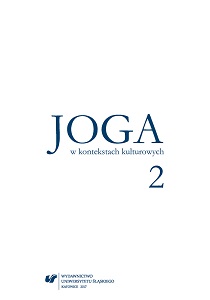
Keywords: yoga; culture; religion; sociology; psychology
Yoga in cultural contexts 2 is a publication associated with a joint project (realised since 2013) of the Department of the Theory and History of Culture of the University of Silesia and of the Department of the Management of Sport and Tourism of the Jerzy Kukuczka Academy of Physical Education in Katowice. Within the framework of this project annual scholarly interdisciplinary paper-workshop conferences are organised (since 2014). These are meetings of researchers who represent inter alia the humanities, social sciences and the sciences of physical education) with the people who practice yoga.The conferences are followed up by publications; although these are not conference volumes strictly speaking; the articles which are featured there are considerably extended versions of papers and the works which are submitted to the editors. In 2016 Wydawnictwo AWF in Katowice published the first volume: Yoga in cultural contexts 1 (ed. Janusz Szopa, Aleksandra Budzisz).Yoga in cultural contexts 2 is also an interdisciplinary work; it contains the works of specialists in the field of cultural studies, indologists, specialists in the field of religion, sociologists and psychologists. There are texts which are devoted to yoga as a complex system of beliefs and practices which are deeply rooted in the cultural context of India as well as to yoga as a phenomenon which gains increasingly greater momentum in the culture of the West. The monograph is supplemented by a dictionary which familiarises the reader with concepts which are important for the problems in question.
More...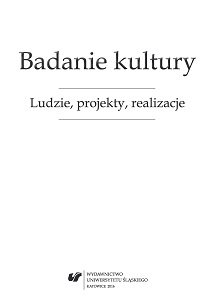
Keywords: Department of Theory and History of Culture; history; structure; research project; didactics
The present monograph presents both the history of the Department of Theory andHistory of Culture, as well as its changing and developing over the years structure. The authors of individual articles have made an attempt at portraying the history of the Department in a broad, historic-cultural, as well as scientific context, taking into account the state of Polish cultural studies and its specificity as a part of the Faculty of Philology of the University of Silesia.The book has been divided into two parts. The first one is devoted to research projects that have so far been carried out by the Department and to the academic profile of the unit. Here one can find a historical overview presenting the process of shaping the community as well as the series of articles devoted to its selected achievements: anthropological field research, model research project devoted to Polish diaspora of Kazakhstan, the concept of cultural anthropology of literature, publications on the issue of shame in culture, memetic and socio-biological aspects of research into culture, as well as the model of the history of culture proposed by the Department.The second part has been devoted mainly to didactic projects (including the history of student research groups at the Department), as well as to the cooperation of the Department with numerous cultural institutions. The reader will find here reflections on the problem of teaching Polish culture, educating teachers on culture studies, as well as educating students in the field of cultural heritage at undergraduate studies. A separate issue is the characteristics of the journal entitled “Laboratorium Kultury” [A Laboratory of Culture] that has relatively recently been set up by the academics of the Department. The last article in the monograph has been devoted to personality basis of scientific culture. The following have been attached to the present monograph: a list of graduates, as well as an appendix presenting important historical documents for Katowice cultural studies.The present book offers a cultural study conceptualization of the problems related to Polish research. The authors of the monograph assume that in order to understand the specificity of any institution, it is necessary to consider its activity in the context of other organizational forms and in the perspective of the longest possible period. Therefore, it is vital to embed the history, achievements, and the contemporary times of The Department of the Theory and History of Culture in the context of local conditioning of the humanities, but also, aspectually, to perceive it in the context of the development of culture studies in Poland, and principally to embed it in the structures of Polish academic system in its organizational, research, and didactic scope. This kind of characteristics of the present through the lens of the past allows to recognize and engineer the future.
More...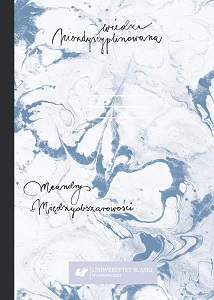
Keywords: Interdisciplinarity; humanities; interdisciplinary individual studies; academic education in Poland
Wiedza niezdyscyplinowana. Meandry międzyobszarowości (“UndisciplinedKnowledge. Meanders of Interdisciplinarity”) is a result of a conference under the same title, which was organized by University of Silesia College of Interdisciplinary Individual Studies in 2015. The character of the conference allowed for a meeting of students, graduates, scientists and academic teachers involved in creating different forms of interdisciplinary individual studies across Poland. Basing on these experiences, the book contains considerations upon a state of interdisciplinary colleges, the notion of interdisciplinarity, as well as some propositions of application of interdisciplinary scientific methods. First part of the volume, Wiedza i dyscyplina? Na drodze do uniwersytetu międzyobszarowego (“Knowledge and Discipline? Towards an Interdisciplinary University”) contains three articles on the subject of university practices and various forms of organization aiming to create scientific and social areas in which interdisciplinarity could be developed. Simultaneously, authors consider dangers and risk associated with these solutions. Ewelina Suszek in her text Między reżimem a anarchią. Problem specjalizacji i interdyscyplinarności (“In-Between Regime and Anarchy. The Problem of Specialization and Interdisciplinarity”)focuses on the problems with specialization in modern humanities as presented in “Enemies of promise: publishing, perishing and the eclipse of scholarship” by Lindsay Waters. Daniel Kontowski’s Co niszczy studia międzyobszarowe w Polsce? Fałszywe wyjaśnienia i poczucie wyższości (“What Destroys Interdisciplinary Studies in Poland? False Explanations and a Sense of Superiority”) presents an in-depth analysis of crisis of Polish Interdisciplinary Individual Colleges. 风 Karolina雅 Pawlik 宋 in Pomiędzy, czyli tu indziej. Kwestia dyscypliny z szanghajskiej perspektywy (“Betwixt, that is Herewhere. The Question of Discipline from Shanghai’s Perspective”), basing on her experience as a student and an academic teacher, compares conditions of higher education in Katowice and in Shanghai.Four subsequent chapters form the second part of the volume, titled Portale i prospekty. Humanistyka na przejściu (‘Portals and Prospectuses. Humanities on the Passage’). Texts in this part are focused on the issue of applications of interdisciplinary approaches to modern humanities. Ryszard Koziołek’s Filologia i John Wayne (“Philology and John Wayne”) presents a vision of new humanities as a social and political force, able to mediate and soothe conflicts. Piotr Bogalecki in his text Dyletant, amator, błazen – humanista w dobie międzyobszarowości (“Dilettante, Amateur, Jester – a Humanist in the Era of Interdisciplinarity”) thinks over different possible stances a humanist can adopt, while obliged to interdisciplinarity. Jan Zając’s Nowe perspektywy w badaniach nad recepcją – przypadek portalu lubimyczytać.pl (“New Perspectives in the Reception Studies – the Case of an Internet Portal lubimyczytać.pl”) is an interdisciplinary, psychological, sociological and philological study on a reception of literature, using opinions posted on the Internet by readers as an research material. Karolina Wycisk in her Taniec jako intersztuka. Neurokognitywiści w badaniach nad tańcem (“Dance as Inter-art. Neurocognitivists in Dance Studies”) examines the influence of neurocognitivism and its methods over the dance studies. The third and last part of the book: Nieludzkie – nieobce. Posthumanizm jako międzyobszarowa praktyka badawcza (“Non-human – Non-alien. Posthumanism as an Interdisciplinary Research Practice”) is focused on the subject of posthumanism as a particular interdisciplinary research field. In three chapters, contained in this part of the volume, authors reflect on a problem how exceeding traditional, humanistic approach could enrich or jeopardize research conducted within the humanities. Miłosz Markiewicz in Przeciw dyscyplinie. Obietnice posthumanistyki (“Against Discipline. The Promises of Posthumanism”) argues that posthumanism, complicating relations between humans and other beings, simultaneously abolishes borders between scientific field and disciplines. Jakub Gawkowski’s Ichtiologia jako nauka pomocnicza historii sztuki (“Ichthyology as an Auxiliary Science of Art History”) is an example of practical application of posthumanist methods, by using some tools of ichthyology to present fishes as a potential subject of art, rather than object, and to criticize unethical artistic practises considering fish. The last text in the volume, Marcin Kozera’s Transcendentny posthumanizm jako radykalna hybryda ducha i materii (“TranscendentPosthumanism as a Radical Hybrid of Spirit and Matter”), explores similarities and differences between posthumanistic theories and mysticism of the Far East.
More...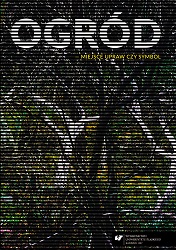
Keywords: garden; symbol; system; photographs
In this book, the notion of the “garden” reveals its numerous aspects – being a system, a symbol, a metaphor, a means of artistic expression, a literary form, an object of scientific research – and is subject to multidimensional scrutiny. The body of the publication is divided into two distinct parts. The former one presents three pivotal topics functioning as a frame for the reflections and detailed descriptions to be found in the latter one. Both parts, in turn, serve as the intellectual “background,” which aims at entering a dialogue with an abundance of meanings carried within images in the collection of photographs placed after the theoretical discourse. As the editors claim, the text and the images together create a net of “permutations,” which should encourage the receiver to co-create aesthetic-intellectual “objects” actively.
More...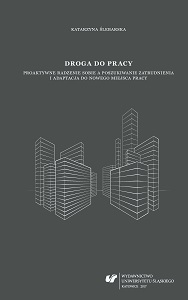
Keywords: proactive coping; job search behaviour; reemployment; job adaptation outcomes
The employment and unemployment structure within the labor market is shaped to a large extent by economic changes and ongoing technological progress. The development of new disciplines and technologies simplifies work and generates demand for certain specialists. Concurrently, industry’s rapid development and informatization contribute to an ever more often depreciation of the human being in favor of the machine. Redefining the concept of professional career, which can no longer be perceived through the lens of workingin the same organization and for one employer during one’s whole life (life-time career), highlights new trends on the labor market, such as temporary, short-term or part-time employment. The risk of job loss becomes realistic, which in turn frequently fosters negativephenomena in the work place such as aggressive rivalry, devaluation of values and moral rules. Unfavorable workplace atmosphere is particularly felt by organizational newcomers. In the entry phase, an employee who is new to an organization needs to gain orientationin the existing expectations regarding their functioning at the workplace at a relatively quick pace. The process of adapting to new vocational settings is often accompanied by feelings of confusion, uncertainty and insecurity. On the one hand, an individual’s adjusting to an organization is influenced by the organization itself, proposing various socializing techniques. On the other hand, new employees themselves actively seek the needed information (Bauer et al., 2007). The theory of organizational socialization (van Maanen & Schein, 1979) highlights that the goal of newcomers is reducing the uncertainty felt in the entry phase so that their environment becomes more predictable (Berger, 1979). Such an approach corresponds withthe process of adapting to a new workplace. The insecurity may be mitigated, among others, by information acquired from various sources, particularly through social interactions with supervisors and coworkers (Saks & Ashforth, 1997). Through various techniques and channels, employees are provided with information that is necessary in order do their job well (role clarification), those concerning possibilities to function well in the face of real requirements of their professional roles as well as those regarding social relations in theworkplace (Miller & Jablin, 1991). The settings that are unfavourable to job integration may lead to vocational exclusion. Phenomena such as unemployment, collective and individualredundancies, striving to reduce overemployment and inability to obtain permanent employment increase rivalry, fear of redundancy and feelings of permanent threat. The individuals who are forced to change their workplace often times face difficulties with findinga new one. Frequently the unemployment period lasts, as a result of which individuals are classified as long-term unemployed. In such circumstances the issue of efficient coping with joblessness becomes vital. In a traditional view, coping with difficulties is most frequently analyzed in the aspect of reactivity. This implies focusing on the stressful events that have already occurred. An individual is oriented towards compensating a loss or wrong that occurred in their past. Even though such mode of coping seems to be adequate while coping with joblessness, the process of seeking new employment requires individuals to go eyond sole reactivity. A question arises regarding the type of coping activity that would prove most useful in the reemployment seeking process. The present work provides empirical verification regarding a proposed answer to this question, namely: proactive coping. With regard to the proactive coping theory (Schwarzer & Taubert, 2002), the coping process is oriented mostlytowards enhancing the resources that are helpful in attaining ambitious and developmental goals. Proactive individuals view difficulties as challenges. In spite of being aware of risks and potential threats, do not perceive them as losses or wrongs (Greenglass & Fiksenbaum,2009a). Proactive coping is mostly analyzed in relation with health and general well-being. The presented research applies the proactive coping theory to a distinctive context, that is, coping with joblessness. The study’s primary focus was understanding unemployed individuals’ job search behaviors. Increased efficiency of job search behaviors leads for reemployment. However, the measure of reemployment success should not be constricted to signing a job contract – it should also involve maintaining the job. For this reason, the newcomers’ process of adapting to the workplace gains crucial importance. Career paths nowadays represent significantly lower linearity and are less connected with one workplace than it could have been observed in the not too distant past (Hall, 2004). Therefore, employees often times face a necessity to change jobs – on average even once every two years (Bauer & Erdogan, 2011). This translates into ongoing involvement in the process of adapting to a new workplace. Hence, effective adaptation to a new workplace is currently becoming an essential issue, and managing the newcomers’ entrance to an organization in a skillfulmanner seems to be the main task within human resources management.The past view on new employees described them as submissive, passive individuals who adjust to their environment and go with the organization’s flow (van Maanen, 1976). However, the concept of Proteus’s career (Hall, 2004; Turska, 2014) highlights thatemployees demonstrate an ever higher responsibility for their own professional development, which increases the significance of individual proactivity (Griffin, Neal, & Parker, 2007). In contrast with the older theorizations, employees are currently perceived as active participants involved in their own adaptation processes (Chan & Schmitt, 2000; De Vos, De Clippeleer, & Dewilde, 2009). Proactive adaptation is described as newcomers playing an active role through demonstrating initiative in learning etc. Proactivity appears to be an element that is even more significant than the support received by new employees in an organization, such as, for example, feedback or advice provided by supervisors (Savickas, 1997). A question can be posed if and in what ways newcomers’ proactivity can be boosted. This work presents results of the Author’s own research works which analyze one of the plausible answers to the mentioned question, namely: through enhancing proactive coping. The study was carriedout in a sample of newly employed workers. It employed an intervention aimed at boosting proactive coping. The research work had two primary goals: firstly, to establish the role of proactive coping in taking actions aimed at finding employment and in the process of adapting to a new workplace that follows reemployment (adaptation results: well-being, role clarification and intention to change jobs), and secondly, to provide an answer to the question if proactive coping can be acquired through training. The first goal was pursued through two independent measurements carried out in the following samples: 1) unemployed people, 2) newly employed workers. The second aim was furthered by measurements conducted in the newcomers’ sample. An important aspect of the analysis was juxtaposing the employees on the basis of their status prior to entering a new organization (unemployed versus employedelsewhere). Due to the results of remaining unemployed, an assumption was made regarding differences in proactive coping between the considered groups. The main focus was on reemployed people, which forms a continuation of the job-seeking process that was analyzedon the grounds of a cross-sectional study carried out in a group of unemployed people.The presented work comprises two parts, namely: theoretical and methodological/empirical one. The theoretical part describes a selection of issues connected with the topic of proactive coping during job search and reemployment, which constitutes the theoretical framework for the Author’s research. This part comprises three chapters. The first one isc centered on the issue of reemployment. It provides readers with an introduction to the issue of unemployment,which remains a serious psychological and social problem, and on the phase of entering a new workplace. Unemployed people were herein portrayed as ones who take actions oriented towards finding employment. Several psychosocial factors accompanying such people’sreemployment were also identified. The adopted perspective that focuses not only on the job-seeking process, but also on the adaptation to a new workplace allows grasping both the success linked with starting a job and remaining in it for a longer period. The emphasis was placed on proactive coping both during job search and adapting to new vocational settings.Chapter two provides a description of proactivity and proactive coping based on the proactive coping theory (Schwarzer, 2000; Taubert, 1999). Proactivity was portrayed in a two-way manner – as an individual’s dispositional trait and as a contextual, changeable factor.Subsequently, the contextual approach to proactivity was highlighted as one allowing a possibility to influence it. When the role of proactive coping as a remedial strategy is considered, it is expected that greater skills at performing proactive coping actions can be acquired through certain activities, for example training.The main area of interest in this work is the ways of dealing with joblessness, i.e. job search behavior (Kanfer et al., 2001), as well as with adapting to a new workplace. Hence, the following third chapter is dedicated to the topic of proactive coping, both while being unemployed and during reemployment. It outlines the predictors of reemployment, namely: job search behavior and expectations towards future job, in relation to the met-unmet expectations theory (Irving & Montes, 2009; Porter & Steers, 1973; Wanous, Poland, Premack, & Davis, 1992). The theoretical part of the work is concluded with an outline of the possible outcomes of the process of coping to a new workplace such as job satisfaction and role clarification. The second part of the work includes a presentation of the Author’s own research results. This part comprises two chapters describing separate studies. The first chapter is embedded into the area of unemployment and focuses on actions connected with job search. The second chapter analyzes the process of adapting to a new workplace following reemployment. Primary emphasis is placed on the outcomes of work adaptation. It describes the research tenets and aims, questions and hypotheses formulated in line with the described research model as well as a description of the samples and measures. While the study of unemployed people was cross-sectional in nature, the one concerning reemployment was longitudinal and also employed an intervention. The intervention, designed by the Author, was aimed at enhancing proactive coping among newcomer employees. For both studies, the outcomes of proactive coping were identified, namely: the intensity of job-seeking actions and new workplace adaptation outcomes, including perceived well-being, role clarification and intention to change jobs. The presented results point to conclusions that are both theoretical and practical in nature. Firstly, the studies test the proactive coping theory in the context of coping with unemployment and reemployment. Regarding this field, the results indicate a salient role of proactive coping in unemployed people during job search andadapting to a new workplace. Secondly, the results portray relationships in a multi-aspect manner. Thirdly, the studies reach beyond the understanding of proactivity that limits it to being a relatively constant personal characteristic. The proposed training, aimed at increasingproactive coping through gathering available resources and enhancing one’s control, indicates a possibility to boost the level of coping proactivity. The results also point out a necessity to pay proper attention to the training methods used with regard to newcomers in order for these methods to be effective in fostering proactive coping. On that account, the result of these research works serve as a useful starting point for additional intervention programs, at the same time highlighting the issues that merit being incorporated while planning such interventions.
More...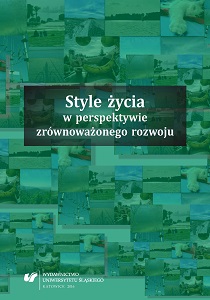
By presenting this book to the public, we intend to enter a stream of reflection about sustainable development. The point of reference which we embrace has to do with a sociological interest in lifestyles.Ecology is a ubiquitous and fashionable concept. For supporters of harmonious functioning of man and the environment, this phenomenon may seem to be desirable and one that realises in an optimistic manner their vision of the world. According to sceptics, the widespread use of this concept contributes to its blurring, and also to its employment as simulation of reality, which actually is not ecological in nature.For sociology, the tracing of such manifestations of “ecologisation” of both everyday and institutional life, which is characterised not only by superficial application of the principles of shallow ecology but above all the consistent adherence to the premises of deep ecology, seems to be an inspirational endeavour.The idea of sustainable development, featured in the Constitution of the Republic of Poland, whose purpose is to design and to implement such conditions of life which will considerably improve its quality, not only in terms of economy, is strictly associated with alternative lifestyles, which attempt to regulate the relations between the individual, the society and the environment. These lifestyles are referred to as alternative due to the various instances of challenging modern manifestations of life characterised by excessive consumerism, Hektik and departure from any forms of spiritual development. The manifestations of this vision of reality include inter alia activities such as downshifting, holistic simplification, culture jamming or behaviour known as freegan. One of such ideas, comprehended in a certain institutional system, is also the idea of the slow life movement, the slowing down of life in all its manifestations. Such an approach is supposed to enable man to indulge in reflection about the condition of the quality of his life and the possibilities of improving it on levels which require such improvement. One of the manifestations of this approach is the emerging network of the cittàslow, initiated in Italy, and which now brings together Polish cities, such as Reszel or Bisztynek, as well. The development of a new quality of life of the residents is a desirable manifestation of developmental success for these cities.
More...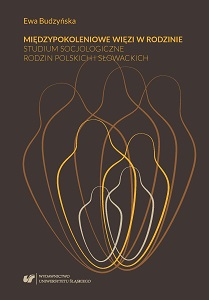
Keywords: family; social ties; intergenerational ties
Since the second half of the 20th century we have been witnessing serious changes in the area of a Western family. These changes encompass all spheres of family life – demographic, cultural (axionormative) and economic – and in this way they contribute to the multiplication of family types. Thus, apart from marriages there appear non-marriage families, apart from complete families there are more and more half-families characterized by a specific kind of matriarchy due to the constant absence of the father. Moreover, apart from permanent families there are families reconstituted after a divorce; apart from families with only one child, and even those that from the very beginning of the relationship rule out the possibility of having children (single-parent families), we can find numerous families; apart from traditional big families extended horizontally, with numerous collateral relatives, territorially settled, there are more and more multigenerational families that are vertically extended, with relatives restricted to lineal blood relation, frequently geographically scattered; apart from families formed by indigenous inhabitants of the West, which is characterized by individualistic culture, more and more common are immigrant families, deriving from countries of familistic cultures, like Asia, Middle East, North Africa, Central and South America, which continue the tradition of intergenerational mutual support. The consequence of this phenomenon are the changes taking place in intergenerational relations within individual family types. Current studies conducted on the quality of family ties (e.g. by Vern L. Bengtson on American family ties and by Leon Dyczewski on intergenerational relation in Polish families) have demonstrated that in contemporary families the generations are still strongly attached to one another. However, inasmuch as formerly the ties were grounded on solid material bases, today their essence is constituted by the affective attitudes of sympathy or antipathy – either facilitating mutual support, reviving interpersonal communication, aiding intergenerational transfer of values, or contributing to cooling off the intergenerational relations, and even (infrequently) to their loss. Therefore, the relations that are still maintained are solidarity relations, as well as emotional, axiological, and in particular communicative ones, and even if some intergenerational conflicts do appear, they typically do not lead to a dramatic break off with the family. The research on the intergenerational ties has also indicated a wide variety of relation types and the degree of their intensification, depending on the direction of the intergenerational tie. The research that well corresponds with such a wide context of views and studies on intergenerational ties is the study on the ties in Polish and Slovak families evaluated by adult, although not yet independent, children. The research has been conducted in 2012 among young students (1047 persons) of two universities: the University of Silesia in Katowice (Poland) and the Constantine the Philosopher University in Nitra (Slovakia). In order to evaluate the research results, an original conception of family ties has been devised, which encompasses the following types of ties: material, object, auxiliary, communicative, emotional, axiological, religious, and recordal. The obtained research results have shown that both the Polish as well as the Slovak families, situated in the countries of similar culture, though of different history, still constitute a strong community of ties, which is especially evident in the case of emotional and auxiliary ties supported by intensive contacts. On the other hand, the least exposed is the material (especially residential) and recordal tie. Moreover, the analyses have demonstrated that young people are deeply interested in supporting intergenerational relations despite some worldview differences and even conflicts which emerge in some spheres. These differences, however, do not result in the attitudes involving breaking away from the family or rejecting it. The intensification of ties in individual dimensions is modified by respondents’ nationality and the degree of their religiousness in terms of their own declaration of faith, while the sex of the respondents has little effect on the intensity of relations. On the basis of the results obtained a conclusion can be drawn regarding the domination of both the Slovak (in higher degree) and Polish (in lesser degree) families by centripetal force which facilitates family integrity. This suggests that integrational processes in the families under scrutiny predominate over disintegrational ones, and the intrafamily ties outweigh extrafamily ties, while the family itself, in both countries being the support for its members during the difficult Times of communist totalitarianism as well as the subsequent political transformation, still performs the function of providing various kinds of assistance and rewarding relations for the young generation. Therefore, the Polish and Slovak families contain more features of the traditional type of family than of the modern type. The obtained picture of the intergenerational ties in the Polish and Slovak families conforms to the research results arrived at by other sociologists, both Polish (e.g. Leon Dyczewski, Hanna Świda-Ziemba, Janusz Mariański) as well as American (Vern L. Bengtson, Karl Pillemer, Andrew J. Cherlin) that confirm the thesis that in contemporary families there exist ties that integrate the generations of children, parents, and grandparents.
More...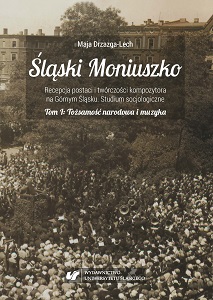
Keywords: the Polish national identity; the Silesian cultural identity; a cultural artefact; collective/social memory; a national/ethnic symbol
The book constitutes the first of the two volumes of the publication entitled „The Silesian Moniuszko. The reception of the figure and the output of the composer in Upper Silesia. A sociological study”, based on research conducted by the author during the work on the dissertation entitled „The construction of national identity through music. The reception of the figure and the output of the composer in Upper Silesia in the 20th century. A sociological study”. The construction of national identity through music is a long process whose bulk progresses in the intersubjective space of social life. The indicator of the occurrence of this process has to do with situations in which the execution and the reception of selected pieces of music, or the reception of the figures of the composers who consciously perform the role of activists engaged in the life of their national community, or to whom the creators of reception ascribe the performance of such a role is accompanied by a process of mythologisation of the given pieces of artistic work to the status of national symbols and that of the given composers to the status of national artists in music. This process is resented on the basis of the example of the reception of the figure and the output of Stanisław Moniuszko. „Listy Stanisława Moniuszki” [„The Letters of Stanisław Moniuszko”] edited by Witold Rudziński and Magdalena Stokowska, were analysed from the perspective of humanist sociology. I focused on an analysis of press reports and the extant written statements of the composer (testimony of the reception of the works of Moniuszko), from which one may draw information about the context of the creation, execution and the presence of the works of Stanisław Moniuszko in the intersubjective cultural space peculiar to a given category of recipients. Moreover, an analysis was conducted upon the ways in which the Moniuszko narration, created by the Związek Śląskich Kół Śpiewaczych [the Association of Silesian Circles of Songsters] in the first half of the 20th century, was present in the Upper Silesian culture. One adopted the periodical “Śpiewak Śląski”/“Śpiewak” of the years 1920–1948 as the unit of analysis. For me, the Moniuszko narration, whose various variants were/continue to be present in the Upper Silesian intersubjective cultural space, constitute an element of social memory/cultural memory. As such, it is involved in the ethnic/national relations (conditioned by the socio-cultural and historical context) which obtain between the inhabitants of the Silesian land, especially between Polishness and Upper Silesianness.
More...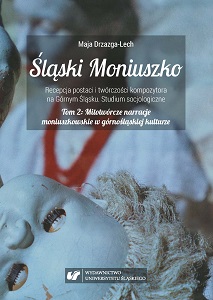
Keywords: Polishness; Upper Silesianness; cultural identity; cultural artefact; symbol
The book which is devoted to the mythopoeic Moniuszko narratives featured in Upper Silesian culture is the second and the final volume of the publication entitled Silesian Moniuszko. The reception of the figure and the output of the composer in Upper Silesia. A sociological study, which is based in its entirety on the PhD dissertation of the author entitled The construction of national identity through music. The reception of the figure and the output of Stanisław Moniuszko in Upper Silesia in the 20th century. A sociological study, which was defended at the Department of Social Sciences of the University of Silesia in 2015.The book presents the results of an analysis associated with the process of the assimilation of the figure and the selected works of Stanisław Moniuszko, approached to as a cultural artefact peculiar to the intersubjective space of Polish cultural identity, to the Upper Silesian culture. What is significant is the fact that along with the transformations of Upper Silesianness which occurred in the 20th century, and especially after the Second World War, also the content which was attributed by the activists of Silesian associated amateur circles of songsters and the creators of the reception of the stage works of the composer presented in Silesia to Stanisław Moniuszko changed. The post-war Upper Silesian reception of Moniuszko formed by the authors of press statements which described the activity of the Silesian amateur choirs and instrumental ensembles – the heirs to the Association of Silesian Circles of Singers – manifested features of double-track mythologisation. On the one hand, sometimes one ascribed to Moniuszko the role of a precursor of Polish socialism, which was consistent with the agenda of the socialist Polish state. On the other hand, one maintained the narrative which rendered the figure of the composer a symbol of the Polishness of Upper Silesia, created by the Association of Silesian Circles of Songsters in the inter-war period. A particularly interesting fact is that within the framework of the activities of this amateur musical association realised after 1989 one disseminated a new Moniuszko narrative – a narrative about the friend of the Silesian team of songsters. This is interpreted as an indicator of a change of the relation which gradually came into being between Silesian culture and the cultures of other nationalities which influenced Silesianness. In the modern documents signed by the Silesian Association of Choirs and Orchestras – the heir to the Association f Silesian Circles of Songsters – Silesianness is presented not only as a value but also as a subjective space, which contains references to other nationalities, including references to Polishness.An analysis of the reception of the figure of Stanisław Moniuszko and his stage works, especially his first opera, Halka, created on the basis of a narrative which refers, respectively to: the performances of Warsaw artists conducted by Emil Młynarski in the plebiscite area in 1920, the activities of the opera stage in Teatr Polski im. Stanisława Wyspiańskiego in Katowice in 1922–1931, guest performances of Moniuszko’s works in Teatr Polski in Katowice in 1932–1939, the activities of Opera Śląska in 1945–2010, also revealed that there is a Moniuszko narrative, peculiar to this region, which refers to the first opera of the composer – “the Silesian Halka”. Another interesting thing has to do with the evolution of the content ascribed to this opera by the creators of the instances of reception which refer to the particular performance of Moniuszko’s work staged in Opera Śląski in Bytom. On the one hand, one constantly mentions the events which constitute the “Silesian heritage” of this work, on the other hand, one ascribes to the author of this work the fulfilment of social roles, whose relevance is dictated by the context of reception: a national artist in Polish music, a precursor of Polish socialism or the creator of works of universal significance.
More...
Keywords: academic dishonesty; determinants; prediction; prevention; educational psychology; higher education;
Academic dishonesty is a phenomenon whose high frequency among students is confirmed by research conducted in Poland, Europe and abroad. It is a problem due to the fact that it leads to a decrease in the knowledge presented by students and the transfer of rewarding experiences related to dishonesty to other areas of life. The aim of this publication is to pre-sent the current knowledge on psychological determinants, prediction, and prevention of academic dishonesty among students, to present the results of research conducted in the above areas and to formulate on their basis conclusions about application possibilities in the academic community.
More...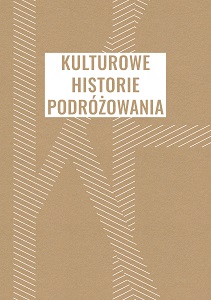
Keywords: travel; history of travel; anthropology of travel; travel literature
This book is an attempt to define historically significant travel models. The variety of texts it contains allows for recreating continuity and change within the complex European discourse. The authors understand travel as a practice causing a transfer of our knowledge and a way to consolidate specific cultural patterns and define their broader contexts. Therefore, it has both symbolic and practical functions, because travel dynamizes history and perpetuates it, consolidates individual cultures from within and becomes a vehicle for mediating beyond their borders. Travel in the perspective outlined in this volume will enable us to see the movements, repetitions, and gaps between patterns, both those matrixing cultural practice and those related to the emergence of discursive orders focused around this practice.
More...